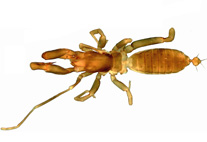Abstract
The genus Mayazomus currently contains two species from southeastern Mexico. It was originally characterized by a strongly elongated pedipalp trochanter, united in its entire width to the femur; the patella strongly curved; the tibia with a large mesal apophysis opposable to tarsus; the spermathecae with two pairs of thin lobes subequal in length; and the presence of four or more setae on tergite II. In the present contribution, the species of the genus Mayazomus are revised and new diagnostic characters for the genus are proposed, including the correction that the female flagellum bears three rather than two annuli. The two known species are redescribed based on examination of the holotypes, plus newly acquired material representing both sexes (female previously unknown for one). Five new species from the Mexican state of Chiapas are described, based on adult males and females: Mayazomus tzotzil new species, Mayazomus aluxe new species, Mayazomus kaamuul new species, Mayazomus yaax new species, and Mayazomus loobil new species. Dimorphism in male pedipalps is reported for the first time for the genus. A dichotomous key is provided for identification of the seven species in the genus; and a distribution map is included.

